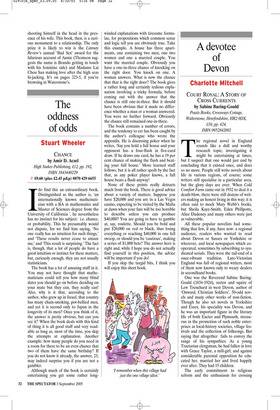Frantic and fantastic
Philip French
FAN-TAN by Marlon Brando and Donald Cammell Heinemann, £16.99, pp. 250, ISBN 043401400 ✆ £13.59 (plus £2.45 p&p) 0870 429 6655 There is now an established tradition of busy stars not reading the books to which they put their names. It stretches from Hedy Lamarr, who 40 years ago sued the ghostwriters of Ecstasy and Me for misrepresentation some while after publication, to Victoria Beckham who claims never to have read a book, not even her autobiography. According to the distinguished film historian, David Thomson, who licked Fan-Tan into shape for publication, it seems likely that the dyslexic Brando belonged to this elite company and never read this posthumously published novel. Without his name on it, the book would never have appeared under the imprint of a reputable publisher.
Fan-Tan is a nautical adventure yarn, several fathoms sub-Conrad, to whom it alludes, and more like a discarded novel by James Clavell, author of Asian sagas such as Tai Pan and Noble House. The central character is the Edinburgh-born, American-naturalised adventurer Anatole Doultry, named after Anatole France but known around the China Seas as ‘Annie’. The year is 1927, he’s 51, skipper of the schooner The Sea Change, and currently doing a six-month stretch in a Hong Kong jail for gun-running. For no particular reason, Annie saves a pirate from the prison gallows, and on his release is drawn by the voluptuous Eurasian pirate queen Lai Cho San into the daring hi-jacking of a British ship transporting silver bullion from Manila to China.
Annie is a handsome man going to seed, but still with muscles that ‘had given his physique when a young man that Hellenic silhouette’. He’s charismatic, tough, sensitive, irresistible to women, a masterly lover with sexual equipment that excites the admiration of both sexes. He’s also a brilliant mimic who can slip in and out of character, and while never betraying his principles is equally capable of acts of wilful cruelty and quixotic deeds of kindness. His understanding of the Eastern world is profound, informed both by observation and intuition. Annie is so obviously Marlon Brando that it’s laughable. Had one come to the book blind, one might have guessed that the author was trying to lure Brando into appearing in a film version, the way Carlos Fuentes shaped the heroine of his novel Old Gringo to seduce Jane Fonda into producing and appearing in the screen adaptation.
But this is a self-portrait of an astonishingly narcissistic kind, written when Brando was slightly older than Annie. It expresses the long-standing affair he had with the Orient and Asian women that began early in his career when he appeared as the Okinawan interpreter in Teahouse of the August Moon in 1956 and immediately thereafter played the US air force officer who defies military protocol and marries a Japanese woman in Sayonara. The association was confirmed when, after a lengthy sojourn in Tahiti filming Mutiny on the Bounty (featuring a Polynesian wife for Fletcher Christian), he bought an atoll there as a personal retreat.
There is, of course, the possibility that Brando’s collaborator, Donald Cammell, who almost certainly wrote every word of this text, made the portrait more flattering than it might originally have been when Brando conceived Fan-Tan as a movie project in the late 1970s. It is often the case that a book or a documentary on the making of a film is more interesting than the movie itself (Lillian Ross’s Picture, for instance, is better than Huston’s Red Badge of Courage on which she was reporting), and David Thomson’s 18-page afterword is far more engaging than Fan-Tan itself.
He explains how Donald Cammell, the self-destructive scion of a wealthy Scottish family, met Brando while a young painter in Paris in 1957, and later wanted the actor to play an American gangster in the transgressive Swinging London movie, Performance (1970), the directorial début that made his name. When Cammell moved to America and fell on hard times, he embarked on an affair with the beautiful under-age daughter of Brando’s onetime Eurasian mistress. This led initially to a breach between them that was later healed when Cammell married the girl. A collaboration then began, initially producing a screenplay. As a way of raising money to finance the film, Cammell turned the scenario into a novel and presumably it was at this point that he introduced the historical material and the pages on ships, wireless telegraphy, guns and the silver trade.
Brando suddenly lost interest, as he often did, and he paid back the advance, all of which had gone to Cammell. The latter lived long enough to read Brando’s pitiful autobiography, in which he didn’t get even a passing mention. Cammell committed suicide in 1996 at the age of 62, shooting himself in the head in the presence of his wife. This book, then, is a curious monument to a relationship. The only prize it is likely to win is the Literary Review’s annual ‘Bad Sex’ award for the hilarious account of Annie (Thomson suggests the name is Brando getting in touch with his feminine side) and Madame Lai Chou San making love after the high seas hi-jacking. It’s on pages 223-5, if you’re browsing in Waterstone’s.










































 Previous page
Previous page